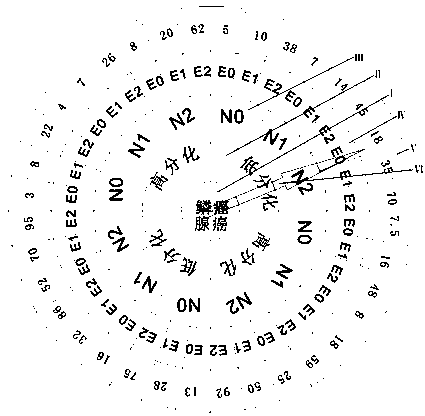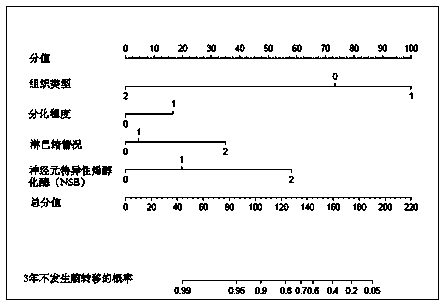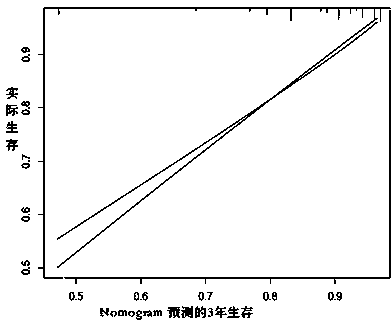Non-small cell lung cancer brain metastases prediction device
A technology of non-small cell lung cancer and prediction device, which is applied in table lookup devices, instruments, computers, etc., can solve the problem of rare research on lung cancer specific organ metastasis prediction.
- Summary
- Abstract
- Description
- Claims
- Application Information
AI Technical Summary
Problems solved by technology
Method used
Image
Examples
Embodiment 1
[0017] see figure 1 , the device of the present invention is composed of the first concentric circle I, the second concentric circle II, the third concentric circle III, the fourth concentric circle IV, the fifth concentric circle V and the indicator needle VI, the first concentric circle I, the second concentric circle Ⅱ. The third concentric circle III, the fourth concentric circle IV, the fifth concentric circle V and the indicator needle VI are fixed together by metal rivets at the same center to form a compass shape. The radius of each concentric circle starts from the first concentric circle I. The fifth concentric circle V is 1cm, 2cm, 3.5cm, 4.8cm, and 6cm, respectively. The indicator needle VI rotates in a circle, and the fingertip of the indicator needle VI is located in the fifth concentric circle V, on the surface of the first concentric circle I along the longitudinal direction. The axis has a center line, the first concentric circle I is divided into half, and t...
Embodiment 2
[0021] Overall use method: Step 1: According to the routine pathology report after non-small cell lung cancer surgery, choose the semicircle of squamous cell carcinoma or semicircle of adenocarcinoma on the compass.
[0022] Step 2: Use the arrows to rotate, according to the degree of differentiation (highly differentiated; poorly differentiated), the number of lymph node metastasis (N0: no metastasis; N1: 1~3 metastasis; N2: >4 metastases), NSE status (E0: 60 ng / ml) to indicate the corresponding numbers.
[0023] The third step: directly read the number on the compass, that is, the risk percentage of brain metastases within 3 years of non-small cell lung cancer.
Embodiment 3
[0025] Specific example 1, a 65-year-old male patient underwent left upper pulmonary sleeve resection + systematic lymph node dissection in the Thoracic Surgery Department of Zhejiang Cancer Hospital in 2011. Postoperative pathological report: 1. Nodular type of left upper lung (tumor 3.5*1.2*1CM) poorly differentiated squamous cell carcinoma, mixed subtype with bronchioloalveolar carcinoma with partial area squamous cell carcinoma, reciprocating the visceral pleura. 2. (Bronchi root of right upper lobe) 1 / 5, (right upper bronchus next to bronchus) 2 / 4, (under carina) 1 / 5, (upper mediastinum) 5, (under carina) 5, (Hilar) One lymph node had chronic inflammation with carbon deposition in some lymph nodes. Immunohistochemical detection of monoclonal antibodies and oncogenes: P53(++)CerbB-2(++)ToPoII(scattered+)MRP(++). Remarks: The bronchial margins were negative. According to the postoperative pathological report of the patient, the clinician selects the semicircle of squamous...
PUM
 Login to View More
Login to View More Abstract
Description
Claims
Application Information
 Login to View More
Login to View More - Generate Ideas
- Intellectual Property
- Life Sciences
- Materials
- Tech Scout
- Unparalleled Data Quality
- Higher Quality Content
- 60% Fewer Hallucinations
Browse by: Latest US Patents, China's latest patents, Technical Efficacy Thesaurus, Application Domain, Technology Topic, Popular Technical Reports.
© 2025 PatSnap. All rights reserved.Legal|Privacy policy|Modern Slavery Act Transparency Statement|Sitemap|About US| Contact US: help@patsnap.com



